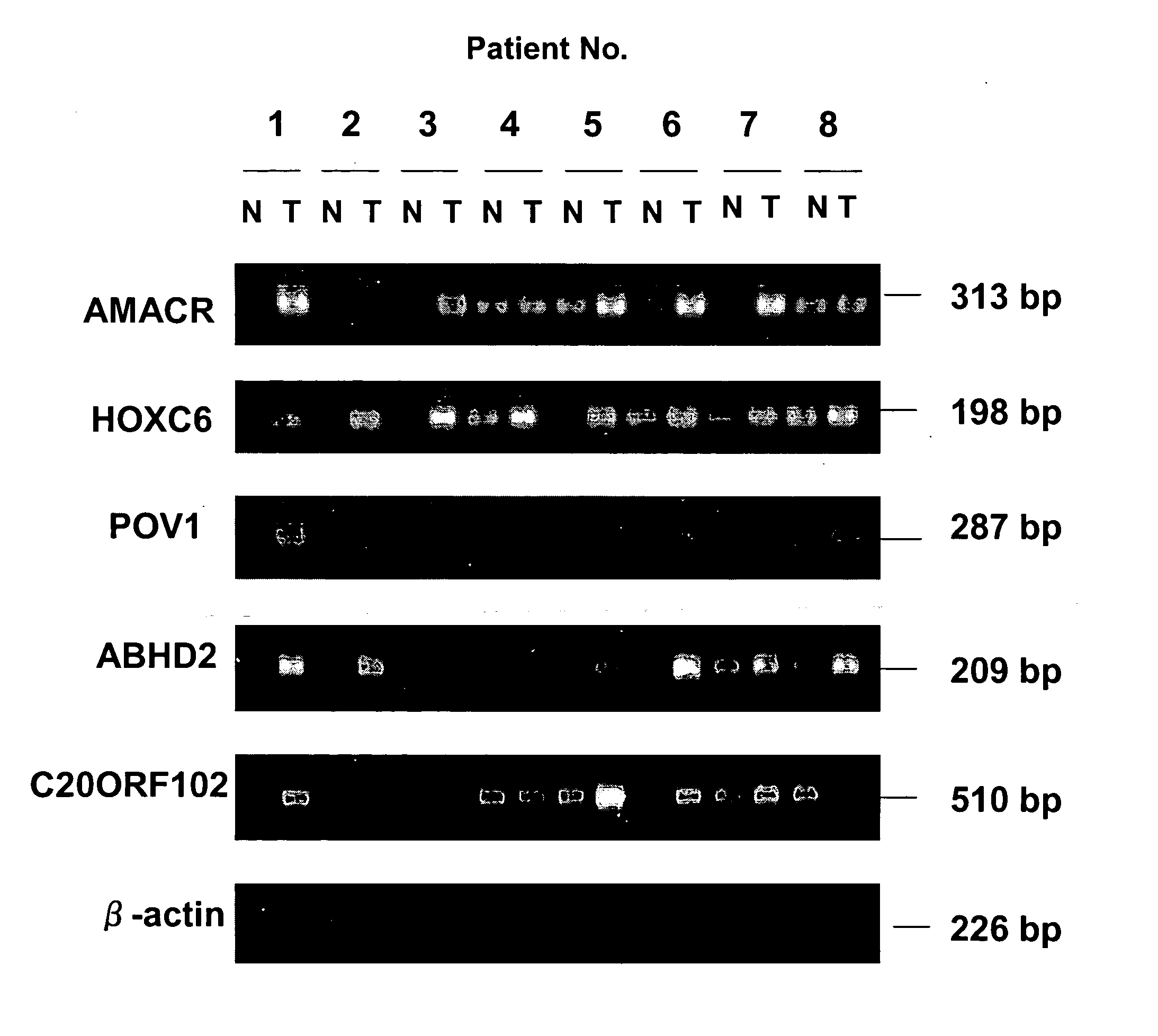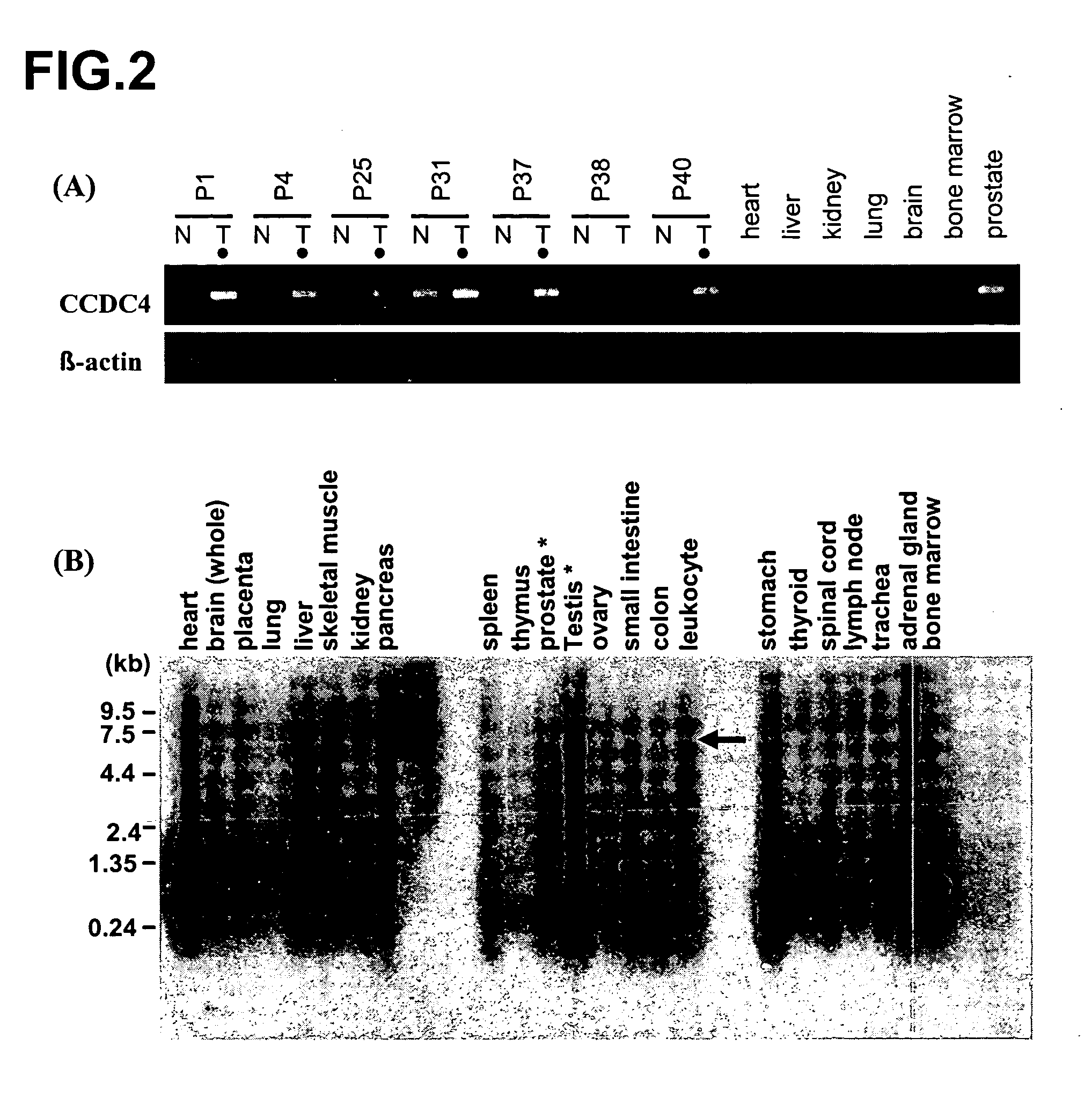Genes and polypeptides relating to prostate cancers
a prostate cancer and polypeptide technology, applied in the field of prostate cancer diagnostic and treatment methods, can solve the problems of significant global health problems and tumors that are no longer responsive, and achieve the effect of reducing tumors and reducing tumors
- Summary
- Abstract
- Description
- Claims
- Application Information
AI Technical Summary
Benefits of technology
Problems solved by technology
Method used
Image
Examples
example 1
Preparation of Test Samples
[0257] Tissue obtained from diseased tissues (e.g., epithelial cells from PRCs) and normal tissues were evaluated to identify genes which are differently expressed or a disease state, e.g., PRC. The assays were carried out as follows.
Patients Tissue Samples and Laser-Capture Microdissection (LCM)
[0258] PRC samples including non-cancerous prostate tissues were obtained from 26 patients who underwent radical prostatectomy without preoperative treatment. Prostate adenocarcinomas or high-grade PINs were histopathologically diagnosed by a single pathologist (M.F.). Among 26 PRC tissues, 20 cancers and 10 high-grade PINs cells that have sufficient amount and quality of RNA to analyze were used for microarray study. Clinical and pathological information on the tumor is detailed in Table 1. Samples were embedded in TissueTek OCT medium (Sakura) and then stored at −80° C. until use. Frozen specimens were serially sectioned in 8-μm slices with a cryostat and sta...
example 2
Identification of PRC-Associated Genes
[0263] When up- or down-regulated genes common to PRC and PINs were identified, the genes were analyzed by the following criteria. Initially, genes whose relative expression ratio was able to be calculated for more than 50% cases and whose expression were up- or down-regulated in more than 50% of cases were selected. The relative expression ratio of each gene (Cy5 / Cy3 intensity ratio) was classified into one of four categories: (1) up-regulated (expression ratio more than 3.0 in more than 50% of the informative; (2) down-regulated (expression ratio less than 0.33 in more than 50% of the informative cases; (3) unchanged expression (expression ratio between 0.33 and 3.0 in more than 50% of the informative cases); and (4) not expressed (or slight expression but under the cut-off level for detection). These categories were defined to detect a set of genes whose changes in expression ratios were common among samples as well as specific to a certain ...
example 3
Identification of a Novel Gene, CCDC4 (Coiled-Coil Domain Containing 4).
[0276] By our genome-wide cDNA microarray, the present inventoers identified one up-regulated spot, housing-name B3537, which represented one EST (Homo sapiens cDNA FLJ35632). Combined the information of other ESTs with the sequence obtained by RACE using prostate cancer cDNA, we identified a novel gene, CCDC4.
Northern-Blot Analysis.
[0277] Human multiple-tissue Northern blots (Clontech, Palo Alto, Calif.) were hybridized with a [α-32P] dCTP-labeled PCR product of B3537. The 361-bp PCR product was prepared by RT-PCR using primers: 5′-GTGACAAATCCATTGATCCTGA-3′ (SEQ ID NO: 5) and 5′-GAACACGTGGCATTCTAGAGGTA-3′ (SEQ ID NO: 6). Pre-hybridization, hybridization and washing were performed according to the supplier's recommendations. The blots were auto-radiographed with intensifying screens at −80° C. for 7 days.
[0278] RT-PCR analysis validated the over-expression of CCDC4 in prostate cancer cells (FIG. 1A). North...
PUM
| Property | Measurement | Unit |
|---|---|---|
| Fraction | aaaaa | aaaaa |
| Fraction | aaaaa | aaaaa |
| Fraction | aaaaa | aaaaa |
Abstract
Description
Claims
Application Information
 Login to View More
Login to View More - R&D
- Intellectual Property
- Life Sciences
- Materials
- Tech Scout
- Unparalleled Data Quality
- Higher Quality Content
- 60% Fewer Hallucinations
Browse by: Latest US Patents, China's latest patents, Technical Efficacy Thesaurus, Application Domain, Technology Topic, Popular Technical Reports.
© 2025 PatSnap. All rights reserved.Legal|Privacy policy|Modern Slavery Act Transparency Statement|Sitemap|About US| Contact US: help@patsnap.com



